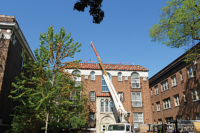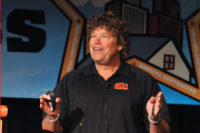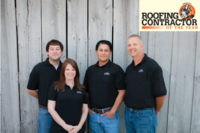The School of Roofology: Ridgeworth Roofing Excels By Becoming Problem Solvers

Ridgeworth Roofing Company is an industrial, commercial and institutional roofing contractor based in Frankfort, Ill. Pictured here are Rodney Petrick, president; Bonnie Petrick, corporate secretary; and Ryan Petrick, vice president. Photo by LeVern A. Danley III.

Rodney Petrick

Bonnie Petrick

Ryan Petrick




Ridgeworth Roofing Company celebrated its 40th anniversary this year, and Rodney Petrick, its president and owner, has been around for 39 years of its history. The Frankfort, Ill.-based company was founded in 1974 by his father, Robert Petrick. Petrick joined the company a year later, right out of high school. He worked his way up through the union apprenticeship program from roofer to journeyman to foreman to superintendent. He took every training course he could find along the way and now jokes that he graduated from the “School of Roofology.”
Petrick credits the company’s ongoing success to quality workmanship performed by its dedicated and experienced crews. But it’s good old-fashioned customer service that sets Ridgeworth Roofing apart. “We’re willing to go in and listen to what our customer’s problem is and try to come up with an affordable solution,” he said. “We’ve had customers for 40 years. You go in there and you become a problem solver. This has become even more important in the last six years in a tough economy.”
The company explores ways to work within customers’ budgets and get the work done, noted Petrick. For example, on a recent large shopping center re-roofing job, the owner couldn’t afford the entire cost in a single quarter, but Petrick was able to break up the job and spread the work out over more than a year, billing him each quarter. The customer was so thankful he recommended Ridgeworth Roofing to the owner of a competing mall.
It’s all part of getting through the economic downturn. “Sometimes you have to come up with some dynamic thinking,” Petrick said. “We’re willing to work with people to help them get through the same tough time we’re all going through, and we’re taking advantage of the opportunities out there in front of us.”
The Chicago Way
Ridgeworth Roofing is a union signatory company with 20 full-time employees. The company focuses on industrial, commercial and institutional projects. Petrick expects the company to do about $5 million in work this year, installing and repairing almost every type of low-slope system. “Believe it or not, we still do a lot of asphalt or coal-tar built-up,” he said. “We run the gamut.”
Most of the company’s work is done on existing roofs. “We’ve had a pretty nice niche — a couple of older industrial areas that my dad had relationships with when he was in the business,” Petrick said. “We’ve stayed in those areas. A lot of people know us, and we’re not afraid to go in there and give them everything from soup to nuts. We’ll take care of whatever they’re looking for and put the project together. We take on a lot of work that other people don’t want, such as difficult deck replacement projects.”
“We want to manage the entire project instead of working with somebody else where we’re just a cog,” he continued. “We want to be the head guy in there and handle all the logistics.”
The Chicagoland area is a very competitive market, noted Petrick, who is proud to go up against other top-notch, dedicated companies who bid against each other but are also willing to lend each other a hand. “That’s one of the best things about being a contractor in Chicago — at any given time, one of us is helping someone else out,” he said. “It’s not that dog eat dog every day.”
Petrick believes his own company history bears that out. “My dad was a plant manager for a roofing materials manufacturer in Chicago. He had his degree in engineering, and he actually got solicited by one of our friendly competitors,” he recalled. “He went to work for the Cronin family at Knickerbocker for about 10 years. When he decided it was time to move on, they actually helped him to get started. To this day, we are very friendly competitors. They are great guys. We help each other out from time to time.”
Competition in the Chicagoland market is tough, but good competitors aren’t the problem, noted Petrick. “The hardest part of competing in a market like this are the people who come in the business who don’t understand what their costs are,” he said. “We’ve been here for 40 years, and obviously we didn’t get here by giving it away. Thankfully most of us out there understand what our costs are.”
A Family Affair
Ridgeworth Roofing has always been a family business. Petrick’s wife, Bonnie, does the books, and his son, Ryan, is vice president and project manager. “Ryan’s been here 11 years already,” Petrick said. “He says he used to come in and work for slave labor.” Ryan also went through the union apprenticeship program, and moved on to project management and Cad drawings. He will begin attending the NRCA’s Future Executives Institute program this fall.
The Petricks are hands-on owners. “We’re on the job every day,” said Petrick. “Our customers like to know there’s an owner out there on the job, and we strive for that. If somebody calls with an issue, I’m going to take the call. When there’s a leak, odds are Ryan or I will show up to take a look at it. I’ve had customers say, ‘I didn’t expect to see you,’ when I show up to determine the problem. But I’m one of those guys who would rather have that face-to-face interaction. Without that, you just become a number.”
Petrick appreciates the education his father gave him, and he’s now in a similar mentoring role with his son. “I could probably write a book on family businesses because I’ve been on both sides of it,” he said. “Working with my dad was a learning experience. I enjoyed it. There were times that we would disagree, but when we walked out of the door to go home, we could stop for a beer and it was like nothing happened.”
Both Petrick and his father would crunch the numbers to make sure they didn’t miss anything. “When we had a difficult project, we would go in our separate offices and I would bid it and he would bid it, and the only things we would share were the material pricing and any subcontractor pricing. And if we were more than 3 or 4 percent apart, we’d have to sit down and figure out why we were different on this.”
It was tough for him to tackle tough bids after his father was no longer there. “When my dad got sick and there was no one else bidding the work, I’d go in the bathroom and argue with the guy in the mirror,” he said. “Sometimes I didn’t like what he had to say. Ryan and I do that now, and we go back and forth. It’s part of that mentoring process.”
Petrick is passing on the knowledge to his son that his father passed on to him. “What will also help Ryan on the business side is that he was accepted into the NRCA FEI program,” he said. “That’s something that wasn’t available when I was around. It’s not like the seat-of-your-pants, school of hard knocks education I had in the industry.”
Overcoming Obstacles
Petrick has seen a lot in his four decades in the industry. He remembers taking on a project with a roof consultant on the corner of Ontario and Michigan in downtown Chicago that posed difficult access issues. “We actually got a permit for Ontario for two consecutive Saturdays — the whole street, from Michigan to Rush, except for the fire lane.”
Unfortunately, the city’s department of transportation was unaware that the Spanish Heritage Parade was scheduled for the second Saturday. “They actually had pictures of me in the newspaper as I’m out there trying to get the ball of a 90-ton crane out of the middle of a parade.”
Other projects were no laughing matter. When Midway Airlines declared bankruptcy in 1991 in the middle of a $900 million project, it was almost the end of Ridgeworth Roofing. “We almost lost the business,” Petrick remembered. “Of all the companies involved in that project, only two survived the hit.”
Ridgeworth was one of them. “We went to the bank and signed our life away,” Petrick said. “Ever since then, we’re very cautious about who we do work for. That was a challenge. You learn how to work extremely lean and extremely smart, because one misstep and you miss your note to the bank. I’ve lived through that, and I don’t ever want to go through that again. We worked too hard to get to where we are today. ”
One key to getting through the cash crunch was the help of distributors and suppliers. Petrick singled out Bone Roofing Supply for going above and beyond the call of duty to help the company. “They told us, ‘We have faith you’ll make it through,’” Petrick said. “They are our key supplier because of that.”
Giving Back
Petrick is active in industry associations on a local, regional and national basis. He is a past president of the Chicago Roofing Contractors Association (CRCA), and a former recipient of Clyde Scott Award, the association’s highest honor. As co-chair of the Industry Affairs and Technical Operations Committee, he often negotiates with the city of Chicago and the state of Illinois on roofing code issues.
He’s also a past president of the Midwest Roofing Contractors Association (MRCA), and in 2013 he received the MRCA’s James Q. McCawley Award, the organization’s highest honor. He’s also active in the National Roofing Contractors Association (NRCA), where he serves as a vice president.
Working with association boards and committees has become a passion for Petrick, who remembers the first time he was asked to serve. “In the early 80s, when your cell phone was still bolted to your truck, I can remember getting a phone call from my dad mentioning that I was going to get a call from Chris Cronin, who was at that time the CRCA president, asking me to serve on the board,” he recalled. “Being a young guy, I said, ‘I have no time for this.’”
His father told him, “You need to give back to the industry you work in,” and promptly hung up on him.
When the call came through, Petrick accepted the position, and he has accepted every other board position he has been offered since then. “A lot of people think board service is voluntary work that takes you away from your business, but I really think it helps you,” he said. “You’re at the forefront of what’s changing and what’s going on in the industry. You gain so much information before it gets trickled down, and you make those relationships.”
Working with industry associations is rewarding, but for Petrick, the best moments are when the company can help the community. Recent community service projects the company provided roofing work for include Shady Oaks Camp, which helps physically and mentally challenged youth, and the LYDIA Home Association, which is dedicated to helping troubled children. “What’s really rewarding is when we can give back and help somebody who is less fortunate,” Petrick said.
Helping the community is a natural extension of helping the company’s customers. Petrick believes it’s the contractor’s duty to educate the owner and stop by periodically to check on the roof. “If we put a roof on your building, we still consider it our roof,” he said. “I have one customer who says, ‘You’re just out here trying to drum up more business.’ And I say, ‘Sure, I’d like some more work, but I’m out here to make sure the investment you paid for, which is an asset now for your building, is performing the way you want.’ That’s the key — getting people to understand it’s not a true expense. It’s an asset to your building, and if you take care of it, it’s going to give you a better return on your investment.”
Looking for a reprint of this article?
From high-res PDFs to custom plaques, order your copy today!









